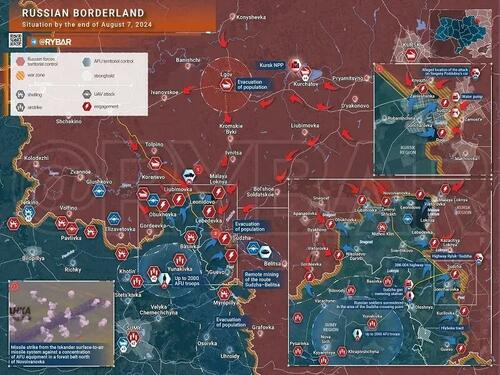
Authored by Andrew Korybko via substack,
Ukraine’s sneak attack against Russia’s Kursk Region appears to have successfully penetrated the border according to RT’s update on Wednesday, which followed the Defense Ministry’s claim that the fighting was only taking place on the Ukrainian side of the border.
Even though it appears destined to fail and be seen in hindsight as this generation’s “Battle of the Bulge” like many social commentators have described it as, it still taught Russia five very important lessons that it would do well to consider implementing:
1. It Might Finally Be Time To Take Out All The Bridges Across The Dnieper
Russia has hitherto been reluctant to take out bridges across the Dnieper, but it might finally be time to do so in order to prevent Western arms and equipment from reaching its pre-2014 borders in possible preparation of more sneak attacks. Continuing to prioritize political objectives over military ones, such as remaining averse to inconveniencing civilians through the proposed means in order to avoid losing more hearts and minds, has arguably proven to have more drawbacks than benefits.
2. Better ISR & Less Groupthink Can Reduce Russia’s Blind Spots
NATO has proven that it has impressive tactical capabilities after successfully disguising its proxy’s sneak attack, but Russia is the bloc’s peer and thus shouldn’t have been fooled. Better intelligence, surveillance, and reconnaissance (ISR) could have prevented this, as could the optimization of feedback loops from the front. Per the latter, higher-ups might not have taken reports of a military build-up seriously since they could have deemed it “irrational”, but they should have listened if that was the case.
3. Preemptive Resettlement & More Physical Border Defenses Would Have Helped A Lot
In hindsight, it might have been wise to preemptively resettle folks who were living in proximity to the border and turn these areas into a security zone with many more physical defenses. Two reasons why this wasn’t done might have been fear of it being spun by its foes as setting up a “buffer zone” inside of Russia and not wanting to inconvenience the locals. The first should never influence policymakers while the second could be mitigated by proper planning and funding (with possible “oligarch” contributions).
4. Border Militias Might Not Be A Bad Idea If They’re Supervised By The State
The now-rebranded Wagner’s late founder Prigozhin had previously proposed creating a border militia in Belgorod Region, but he ultimately turned out to be the West’s “useful idiot” as explained in the preceding hyperlinked analysis so that might have been a very bad idea at the time had he succeeded. Nevertheless, properly supervised border militias might in fact be a good idea, such as if there were FSB agents embedded within them to ensure these non-state actors’ continued loyalty to the state.
5. “Active Defense” Is Better Than “Passive Defense”
Even in the absence of proper ISR, Ukraine would have still struggled to assemble the forces needed for its sneak attack and then storm across the border had Russia been engaged in a policy of “active defense” (regular low-level attacks) instead of “passive defense” (sitting back and waiting for an attack). Going forward, Russia should consider the merits of implementing “active defense” all along the front, which would keep Ukraine on edge and possibly force it to voluntarily create its own “buffer zones”.
The five lessons enumerated above could reshape how policymakers perceive the special operation and therefore improve the way in which it’s being waged, particularly with regards to addressing some of the constructive critiques thereof that were shared in this analysis here from November 2022. Retaining the same mindset risks more sneak attacks.
It’s only through the pragmatic evolution of policymakers’ viewpoints in response to the past 2.5 years’ events that success can best be achieved.
Authored by Andrew Korybko via substack,
Ukraine’s sneak attack against Russia’s Kursk Region appears to have successfully penetrated the border according to RT’s update on Wednesday, which followed the Defense Ministry’s claim that the fighting was only taking place on the Ukrainian side of the border.
Even though it appears destined to fail and be seen in hindsight as this generation’s “Battle of the Bulge” like many social commentators have described it as, it still taught Russia five very important lessons that it would do well to consider implementing:
1. It Might Finally Be Time To Take Out All The Bridges Across The Dnieper
Russia has hitherto been reluctant to take out bridges across the Dnieper, but it might finally be time to do so in order to prevent Western arms and equipment from reaching its pre-2014 borders in possible preparation of more sneak attacks. Continuing to prioritize political objectives over military ones, such as remaining averse to inconveniencing civilians through the proposed means in order to avoid losing more hearts and minds, has arguably proven to have more drawbacks than benefits.
2. Better ISR & Less Groupthink Can Reduce Russia’s Blind Spots
NATO has proven that it has impressive tactical capabilities after successfully disguising its proxy’s sneak attack, but Russia is the bloc’s peer and thus shouldn’t have been fooled. Better intelligence, surveillance, and reconnaissance (ISR) could have prevented this, as could the optimization of feedback loops from the front. Per the latter, higher-ups might not have taken reports of a military build-up seriously since they could have deemed it “irrational”, but they should have listened if that was the case.
3. Preemptive Resettlement & More Physical Border Defenses Would Have Helped A Lot
In hindsight, it might have been wise to preemptively resettle folks who were living in proximity to the border and turn these areas into a security zone with many more physical defenses. Two reasons why this wasn’t done might have been fear of it being spun by its foes as setting up a “buffer zone” inside of Russia and not wanting to inconvenience the locals. The first should never influence policymakers while the second could be mitigated by proper planning and funding (with possible “oligarch” contributions).
4. Border Militias Might Not Be A Bad Idea If They’re Supervised By The State
The now-rebranded Wagner’s late founder Prigozhin had previously proposed creating a border militia in Belgorod Region, but he ultimately turned out to be the West’s “useful idiot” as explained in the preceding hyperlinked analysis so that might have been a very bad idea at the time had he succeeded. Nevertheless, properly supervised border militias might in fact be a good idea, such as if there were FSB agents embedded within them to ensure these non-state actors’ continued loyalty to the state.
5. “Active Defense” Is Better Than “Passive Defense”
Even in the absence of proper ISR, Ukraine would have still struggled to assemble the forces needed for its sneak attack and then storm across the border had Russia been engaged in a policy of “active defense” (regular low-level attacks) instead of “passive defense” (sitting back and waiting for an attack). Going forward, Russia should consider the merits of implementing “active defense” all along the front, which would keep Ukraine on edge and possibly force it to voluntarily create its own “buffer zones”.
The five lessons enumerated above could reshape how policymakers perceive the special operation and therefore improve the way in which it’s being waged, particularly with regards to addressing some of the constructive critiques thereof that were shared in this analysis here from November 2022. Retaining the same mindset risks more sneak attacks.
It’s only through the pragmatic evolution of policymakers’ viewpoints in response to the past 2.5 years’ events that success can best be achieved.
Loading…




